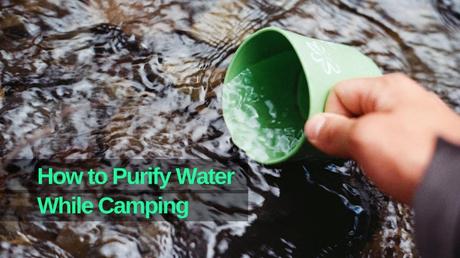
Are you planning your next outdoor expedition?
It doesn't matter if you are hiking, camping or walking those uncharted trails. Any unexpected train of events could lead to a survival situation where you might be left to fend for yourself. In such cases staying hydrated will surely be of utmost importance.
Knowing how to purify impure water can save your day!
Necessary hydration on such lengthy and hefty expeditions cannot be overlooked. Naturally, a person consumes a gallon of water per day while hiking. Moreover, if the weather is dry or humid, the quantity increases up to 3 gallons. Thus, if you exhaust the water you had stocked up, you will need to filter dirty water and obtain portable water to keep yourself hydrated along the journey.
In this article, we'll explain some water purification techniques for your convenience.
Is the water found in pits and ponds safe to drink?
Simply, no!
Untreated water may contain harmful elements like pollutants, parasites, bacteria, and viruses. Drinking unfiltered or unpurified water could lead to severe health conditions. The risk could quickly escalate since you are outdoor, and getting help will be very time consuming and uncertain.
Therefore, it is always safer to filter and purify the water before consuming it. Before diving deeper into the ways to purify water, first you need to understand the difference between water purification and water filtration.
Water filtration
Water filtration is a technique of removing impurities from water.
Water can be filtered using a physical barrier, biological and chemical process. Filtering water removes the murkiness, most of the bacteria and microbial cysts. However, water that looks clean is not always safe to drink. It can still contain harmful microorganisms and chemical contaminants that are not removed just by filtration.
Water purification
Water purification is a process that deals with making the water safe to drink.
Water purification involves the use of chemicals like chlorine or iodine to get rid of all the harmful components like biological contaminants, viruses, and chemicals. Note that water filtration should be followed by purification to get water that is completely safe to drink.
Handy Water purification techniques
1. Boiling
Obviously!
The oldest and most basic way to make water suitable for drinking is by boiling.
Boiling the water will get rid of most of the harmful disease-causing pathogens. Collect some water and rolling boil it up to 1 minute when you are at sea level. However, at higher altitudes, since the atmospheric pressure is low, it takes more time to reach a high temperature. Generally at or above 6500 feet, boiling the water for 3 minutes will purify the water of any harmful pathogens and will be safe to drink.
2. Distillation
Water distillation proves to be more effective than boiling, and you can be sure to obtain safer and cleaner water.
In hot or humid climates where the temperature is generally high, distillation can make a huge difference. Impure water may contain many salts and harmful chemical elements which have the potential to generate serious health problems.
The process of distillation is very simple to carry out. You'll need a large container to hold water to be purified, a small container to collect pure water, a plastic bag, and a rock. Proceed by digging a hole and place the large container in it. Place the small container in the middle of the large container and cover the pit using the plastic and seal any opening. Finally, place the rock at the center of the plastic, creating a depression exactly above the small container.
This is nature's way of applying physics. The heat trapped inside will cause the water to evaporate. The water vapor gets condensed on the plastic and form water droplets. Due to the depression, the water will be directed into the small container. The water collected into the small container will be safe to drink.
Another way to do it is by using a plastic bottle and sunlight. See the video below -
3. Purification tablets
Easy to use and carry, effervescent tablets is one of the easiest and most effective way to get portable water.
Generally, a tablet will be used to purify 25 liters of water. Powerful tablets can purify impure water up to 70 liters for a large group. It takes 30 minutes for a tablet to completely get rid of the parasites in the water before you can drink it.
Parasites like Cryptosporidium present in impure water causes your stomach to get severely upset, and you could suffer from constant coughing.
Water purification tablets can be iodine or chlorine dioxide-based. Being much weaker than the chlorine dioxide tablets, iodine tablets fail to get rid of Cryptosporidium. Chlorine dioxide tablets tackle this problem for you by destroying a variety of parasites.
That being said, you will need to wait for up to 4 hours before the water gets completely purified and is safe to drink.
4. Carrying water filters
When you are on the trail, carrying a light-weight water filter is the best way to go.
Water filters can purify water with a specifically designed filtration system that gets rid of the parasites like Cryptosporidium and Giardia, which causes serious health problems.
A squeeze water filter can be your travel buddy. It's light-weight and can be packed in the sack. You can directly sip water from a pond or a creek or store dirty water in a bottle attached to the sipper that contains the filtration mechanism.
Pump water filter works on the same technology, but instead of sipping the water, you have to pump the water through the filter using a pump.
For filtering water for large groups, a gravity water filter would prove to be a good decision. Gravity filters work on the concepts of gravity. Water is collected in a container that is attached to a filtration mechanism. This unfiltered water drips down as it passes through the filters and gets collected in a container below. The collected water is free from any impurities and safe to drink.
5. UV rays treatment
This is probably one of the easiest ways to purify water naturally. All you have to do is fill plastic or glass bottles with filtered water, remove the labels if there are any and keep the bottle in sunlight. The UV rays from the sun will kill all the harmful parasites leaving behind purified water.
Depending on the weather, keeping the bottle for 4 hours on a sunny day and longer in case of the cloudy day will surely do the job.
Wrapping up
While on a trekking or camping adventure, keeping yourself hydrated is one of the most important things to do. Though you won't face any problems during a short family camping trip, if you utilize all the water supply, you have to know effective ways to get clean water to drink by purifying water from a pond or a lake.
Water purification techniques mentioned above are easy and affordable to make water safe for drinking. We hope you have learned one more skill to add in your survival list and might come handy in an unexpected situation.
If you have more techniques to share, feel free to write in in the comment section below.
Happy camping!
I'm currently working as the SEO and Content Manager at Bigberkeyfilters. I have a long experience in producing content related to all things 'water'. As an environmental and health enthusiast, I consider it as my duty to spread awareness about water pollution and how it affects human health and the environment. Tejas Shahakar (Guest author)

